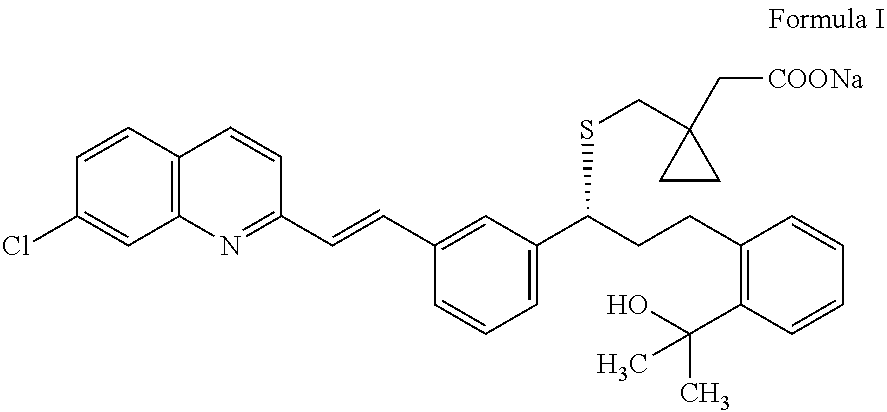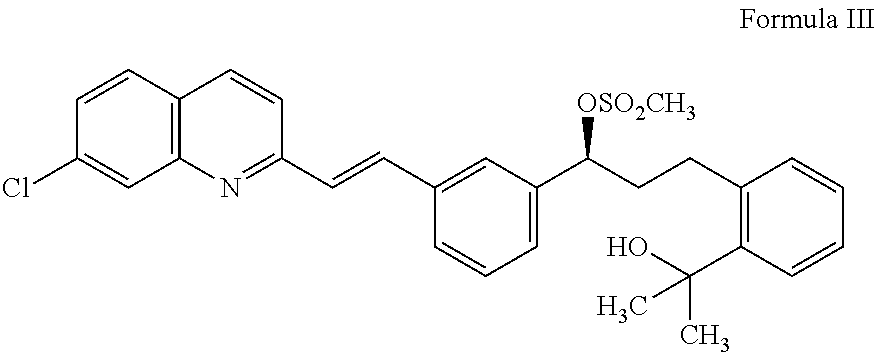Preparation of montelukast and its salts
a technology of montelukast and salt, which is applied in the field of processes for preparing montelukast acid and its salts, can solve problems such as uneconomical processes, and achieve the effect of low yield
- Summary
- Abstract
- Description
- Claims
- Application Information
AI Technical Summary
Benefits of technology
Problems solved by technology
Method used
Image
Examples
example 1
Preparation of Montelukast Acid Using Resin as a Desalting Agent
(A) Preparation of Dicyclohexylamine Salt of Montelukast
[0078]An organic layer obtained by the procedure described in the Reference Example, starting from 30 g of 2-(2-(3(S)-(3-(2-(7-chloro-2-quinolinyl)ethenyl)phenyl)-3-hydroxypropyl)phenyl)-2-propanol, was charged into a round bottom flask followed by addition of dichloromethane (450 mL). Styrene-divinylbenzenesulfonic acid resin (50 g) and water (240 mL) were charged, stirred for about 30 minutes, and the resin was removed by filtration. The organic and aqueous layers were separated followed by washing the organic layer with water (2×240 mL). The organic layer was distilled completely at about 50° C. under reduced pressure. To the obtained residue, acetonitrile (2×48 mL) was added and distilled completely to remove traces of dichloromethane. The obtained residue was dissolved in acetonitrile (225 mL) and isopropanol (90 mL) at about 30±5° C. Dicyclohexylamine (17 mL)...
example 2
Preparation of Montelukast Acid Using Resin as a Desalting Agent
(A) Preparation of Dicyclohexylamine Salt of Montelukast
[0080]An organic layer obtained by the procedure described in the Reference Example, prior to desalting, starting from 16 g of 2-(2-(3-(S)-(3-(2-(7-chloro-2-quinolinyl)ethenyl)phenyl)-3-hydroxypropyl)phenyl)-2-propanol, was charged into a round bottom flask followed by addition of dichloromethane (240 mL), and the mixture was stirred for about 10 minutes. TULSION T63 resin (27 mL) and water (128 mL) were charged and stirred for about 30 minutes at about 30±5° C. and the resin was removed by filtration. The filtrate was washed with dichloromethane (32 mL). The organic and aqueous layers were separated, followed by washing the organic layer with water (2×128 mL). The organic layer was distilled completely at about 50° C. under reduced pressure. To the obtained residue, acetonitrile (2×48 mL) was added and distilled completely to remove the traces of dichloromethane. ...
example 3
Preparation of Montelukast Acid Using Ammonium Chloride as a Desalting Agent
(A) Preparation of Dicyclohexylamine Salt of Montelukast
[0082]An organic layer obtained by the procedure described in the Reference Example, prior to desalting, starting from 30 g of 2-(2-(3-(S)-(3-(2-(7-chloro-2-quinolinyl)ethenyl)phenyl)-3-hydroxypropyl)phenyl)-2-propanol, was charged into a round bottom flask followed by addition of dichloromethane (450 mL) and stirred for about 10 minutes. Saturated ammonium chloride solution (240 mL) was charged slowly and stirred for about 30 minutes. The organic and aqueous layers were separated, followed by washing the organic layer with water (2×240 mL). The organic layer was distilled completely at about 50° C. To the obtained residue, acetonitrile (2×90 mL) was added and distilled completely to remove traces of dichlormethane. The obtained residue was dissolved in acetonitrile (225 mL) and isopropanol (90 mL) at about 25° C. Dicyclohexylamine (15.43 g) was added a...
PUM
| Property | Measurement | Unit |
|---|---|---|
| temperatures | aaaaa | aaaaa |
| temperatures | aaaaa | aaaaa |
| temperatures | aaaaa | aaaaa |
Abstract
Description
Claims
Application Information
 Login to View More
Login to View More - R&D
- Intellectual Property
- Life Sciences
- Materials
- Tech Scout
- Unparalleled Data Quality
- Higher Quality Content
- 60% Fewer Hallucinations
Browse by: Latest US Patents, China's latest patents, Technical Efficacy Thesaurus, Application Domain, Technology Topic, Popular Technical Reports.
© 2025 PatSnap. All rights reserved.Legal|Privacy policy|Modern Slavery Act Transparency Statement|Sitemap|About US| Contact US: help@patsnap.com



